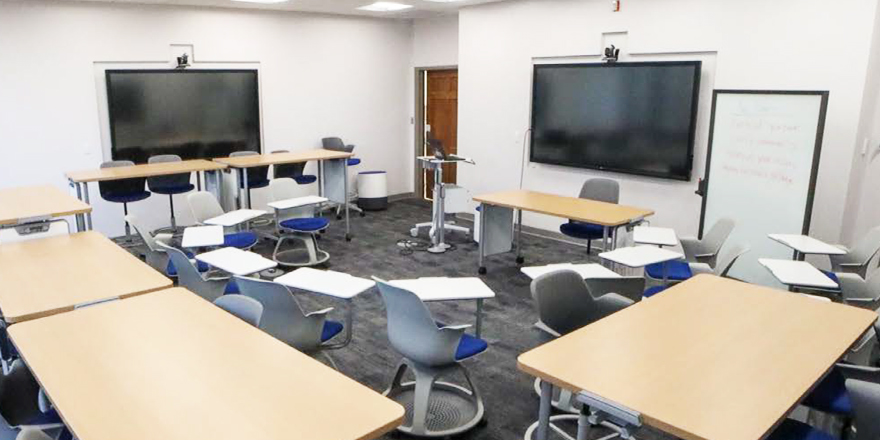Founded in 1789, Georgetown University, in Washington, D.C., is the oldest Jesuit Catholic institution of higher education in the United States. It is also among the most forward-thinking universities when it comes to applying new technology to learning. Twenty years ago, Georgetown launched its Center for New Designs in Learning and Scholarship (CNDLS), one of the nation’s first higher education programs aimed at bridging pedagogy and technological innovation.
In 2019, the CNDLS team wanted to reimagine learning spaces through collaborative technology. Working with LG Business Solutions and local technology integrator CTSI, Georgetown introduced a multi-dimensional classroom to faculty and students, to support small- and large-group exploration, interactivity, distance learning, and more.
According to CTSI, Georgetown wanted a dual-display setup that could support remote participants on one screen and presentation material on the other. They also wanted a single-display system like one might see in a standard classroom. And they wanted smaller groups of students to be able to gather around several different displays, connect and collaborate.
The final design, which first welcomed students and teachers in the fall of 2019, includes a pair of large (75-inch), 4K, interactive LG touch displays at one end of the room, a third 86-inch LG interactive 4K display at the other, and a fourth 86-inch LG 4K display on one side, opposite the classroom’s bank of windows. Video cameras are installed on each wall for connecting directly to Georgetown’s Zoom video conferencing system; ceiling speakers and microphone arrays for tracking speakers in the room and optimizing audio on other ends of a Zoom session; and four collaboration pods, which users can connect to wirelessly to share content on the room’s displays.
There is no actual “front” of the room, and all the displays can be used by instructors and students alike. This creates a collaborative space where students can work together on the same screen or multiple screens at one time. For lectures, a professor can use one or more displays for the presentation or set them up as a gallery walk.
For Georgetown, it’s a real-world application of new technology to an active-learning pedagogy. After the professor’s five- or 10-minute presentation the rest of the class is experiential, with discovery and inquiry-based learning.
Everything in the room is managed through a professional AV control system and touch panel. With four different large-screen touch displays and one classroom computer, the control system manages which touch display is controlling the computer during presentations.
When professors initiate a videoconference, they go to the touch panel, select Zoom, select where they want the remote participants displayed and where they want the presentation displayed, select the screen, then control it via the LG touchscreen display.
Faculty has been quick to adopt the classroom technology. When the CTSI and LG teams visited to familiarize users with the installed systems, the wireless collaboration pods, for example, were well received by faculty and students alike. Because users can connect to the pods from their smartphones and begin sharing content on the room’s LG displays, the learning curve was minor.
Read the full “Georgetown Embraces Integrated Technologies” case study for all the details here.
